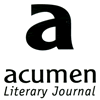Responses
Dear Acumen,
What nonsense does James Aitchison write in his Natural History of the Muse in A.49. (a) There are nine, just because he has no experience of one muse does not demonstrate that the other eight do not exist. (b) Has he not read even John Fowles Mantissa’?
Andrew Robinson
Truro
James Aitchison replies:
‘A Natural History of the Muse’, was written in the belief that the function of mind that transforms an abstract quality into a person is similar to the function that transforms the abstract religious impulse into a god; indeed, the two processes, personification and deification, could be variations on the same theme. Fundamental to that theme is the mind’s remarkably fluid play with multiple identities of godhood and selfhood. One function of mind, or set of functions, personifies and deifies and then, as if separately and independently, another function or set of functions projects the personified and deified abstractions into worlds outside the mind. If this is so, then the concept of the poetic muse is less compelling.
Implicit in ‘A Natural History of the Muse’ is the belief that most functions of mind, including the poetic imagination and the creative impulse that drives the imagination, are common to women and men. The masculine / feminine antithesis is false, because in English-language poetry there are no subjects or themes, no forms or styles, no uses of language, no poetic visions or even poetic voices that are exclusive to female or male poets. Examples such as stanzas from Anne Sexton’s ‘January 1st’ and from Edwin Muir’s ‘The Little General’ show women’s and men’s poetic imaginations working in similar ways. See also comparable stanzas from Hugh MacDiarmid’s ‘Bracken Hills In Autumn’ and Amy Clampitt’s ‘The Sun Underfoot Among the Sundews’; and John Davidson’s ‘Snow’, and Patricia Beer’s ‘Icicles’.
(This correspondence is now closed – Ed.)
Page(s) 124-125
magazine list
- Features

- zines

- 10th Muse
- 14
- Acumen
- Agenda
- Ambit
- Angel Exhaust
- ARTEMISpoetry

- Atlas
- Blithe Spirit
- Borderlines
- Brando's hat
- Brittle Star

- Candelabrum
- Cannon's Mouth, The
- Chroma
- Coffee House, The
- Dream Catcher
- Equinox
- Erbacce
- Fabric
- Fire
- Floating Bear, The
- French Literary Review, The
- Frogmore Papers, The
- Global Tapestry
- Grosseteste Review
- Homeless Diamonds
- Interpreter's House, The
- Iota
- Journal, The
- Lamport Court
- London Magazine, The
- Magma
- Matchbox
- Matter
- Modern Poetry in Translation
- Monkey Kettle
- Moodswing
- Neon Highway
- New Welsh Review
- North, The
- Oasis
- Obsessed with pipework
- Orbis
- Oxford Poetry
- Painted, spoken

- Paper, The
- Pen Pusher Magazine

- Poetry Cornwall
- Poetry London
- Poetry London (1951)
- Poetry Nation
- Poetry Review, The
- Poetry Salzburg Review
- Poetry Scotland
- Poetry Wales
- Private Tutor
- Purple Patch
- Quarto
- Rain Dog
- Reach Poetry
- Review, The
- Rialto, The
- Second Aeon
- Seventh Quarry, The
- Shearsman
- Smiths Knoll
- Smoke
- South
- Staple
- Strange Faeces
- Tabla Book of New Verse, The
- Thumbscrew
- Tolling Elves
- Ugly Tree, The
- Weyfarers
- Wolf, The

- Yellow Crane, The
